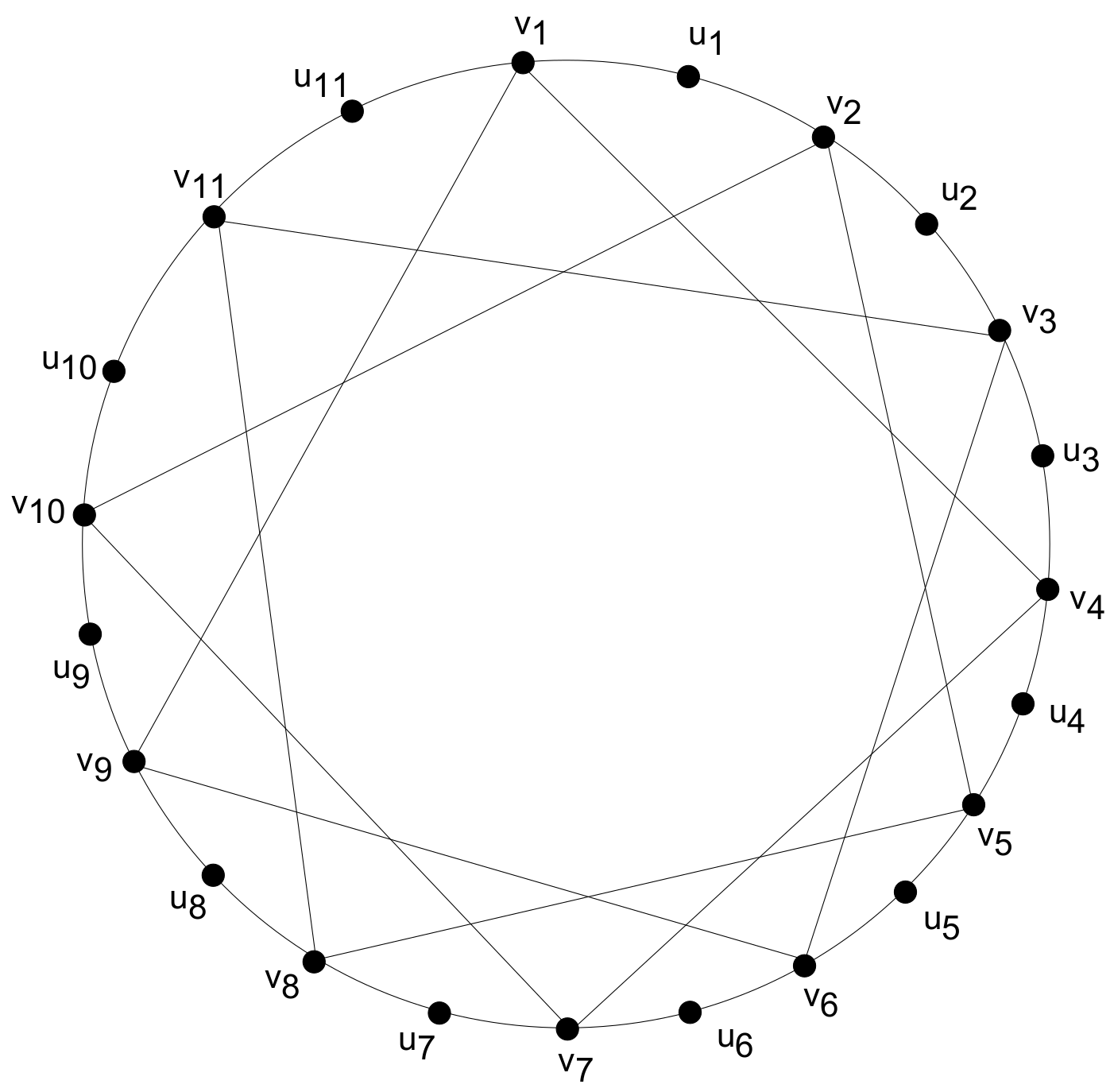Resolvability in Subdivision Graph of Circulant Graphs
Abstract
:1. Introduction and Preliminary Results
1.1. Metric Dimension of Subdivision of Circulant Graph
- .
- .
- If all the vertices of W belong to .
- If W contain one vertex from . Assume, without being too specific, that . The vertices that have representation for each choice of i and j are listed below:
1.2. Metric Dimension of Subdivision of Circulant Graph
2. Conclusions
Author Contributions
Funding
Institutional Review Board Statement
Informed Consent Statement
Data Availability Statement
Acknowledgments
Conflicts of Interest
References
- Chartrand, G.; Eroh, L.; Johnson, M.A.; Oellermann, O.R. Resolvability in graphs and metric dimension of a graph. Disc. Appl. Math. 2000, 105, 99–113. [Google Scholar] [CrossRef] [Green Version]
- Cameron, P.J.; Lint, J.H.V. Designs, Graphs, Code and Their Links; Cambridge University Press: Cambridge, MA, USA, 1991. [Google Scholar]
- Khuller, S.; Raghavachari, B.; Rosenfeld, A. Localization in Graphs; Technical Report CS-TR-3326; University of Maryland at College Park: College Park, MD, USA, 1994. [Google Scholar]
- Sebö, A.; Tannier, E. On metric generators of graphs. Math. Oper. Res. 2004, 29, 383–393. [Google Scholar] [CrossRef]
- Slater, P.J. Leaves of trees. Congress. Numer. 1975, 14, 549–559. [Google Scholar]
- Slater, P.J. Dominating and refrence sets in graph. J. Math. Phys. Sci. 1988, 22, 445–455. [Google Scholar]
- Harary, F.; Melter, R.A. On the metric dimension of a graph. ARS Combin. 1976, 2, 191–195. [Google Scholar]
- Melter, R.A.; Tomescu, I. Metric bases in digital geometry. Computer Vision Graph. Image Process. 1984, 25, 113–121. [Google Scholar] [CrossRef]
- Ahmad, A.; Imran, M.; Al-Mushayt, O.; Bokhary, S.A.U.H. On the metric dimension of barcycentric subdivision of Calays graphs. Misk. Math. Notes 2015, 16, 637–646. [Google Scholar]
- Imran, M.; Bokhary, S.A. On Resolvability in Double-Step Circulant Graphs. UPB Sci. Bull. Ser. A 2014, 76, 31–42. [Google Scholar]
- Imran, M.; Baig, A.Q.; Bokhary, S.A.U.H.; Javaid, I. On the metric dimension of circulant graphs. Appl. Math. Lett. 2012, 25, 320–325. [Google Scholar] [CrossRef] [Green Version]
- Tamar, M.S. Planar Graphs and Wagner’s and Kuratowski’s Theorems; OEIS: Las Vegas, NV, USA, 2016. [Google Scholar]
- Wei, J.; Bokhary, S.A.U.H.; Abbas, G.; Muhammad, I. Resolvability in Subdivision of Circulant Networks Cl[1,k]. Discret. Dyn. Nat. Soc. 2020, 2020, 4197678. [Google Scholar] [CrossRef]
- Toit, L.D.; Vertp´k, T. On the metric dimension of circulant graphs with 2 generators. Kragujevac J. Math. 2019, 43, 49–58. [Google Scholar]
- Vertp´k, T. On the metric dimension of circulant graphs with 4 generators. Contrib. Disc. Math. 2017, 12, 104–114. [Google Scholar]


Disclaimer/Publisher’s Note: The statements, opinions and data contained in all publications are solely those of the individual author(s) and contributor(s) and not of MDPI and/or the editor(s). MDPI and/or the editor(s) disclaim responsibility for any injury to people or property resulting from any ideas, methods, instructions or products referred to in the content. |
© 2023 by the authors. Licensee MDPI, Basel, Switzerland. This article is an open access article distributed under the terms and conditions of the Creative Commons Attribution (CC BY) license (https://creativecommons.org/licenses/by/4.0/).
Share and Cite
Bokhary, S.A.U.H.; Wahid, K.; Ali, U.; Hilali, S.O.; Alhagyan, M.; Gargouri, A. Resolvability in Subdivision Graph of Circulant Graphs. Symmetry 2023, 15, 867. https://doi.org/10.3390/sym15040867
Bokhary SAUH, Wahid K, Ali U, Hilali SO, Alhagyan M, Gargouri A. Resolvability in Subdivision Graph of Circulant Graphs. Symmetry. 2023; 15(4):867. https://doi.org/10.3390/sym15040867
Chicago/Turabian StyleBokhary, Syed Ahtsham Ul Haq, Khola Wahid, Usman Ali, Shreefa O. Hilali, Mohammed Alhagyan, and Ameni Gargouri. 2023. "Resolvability in Subdivision Graph of Circulant Graphs" Symmetry 15, no. 4: 867. https://doi.org/10.3390/sym15040867
APA StyleBokhary, S. A. U. H., Wahid, K., Ali, U., Hilali, S. O., Alhagyan, M., & Gargouri, A. (2023). Resolvability in Subdivision Graph of Circulant Graphs. Symmetry, 15(4), 867. https://doi.org/10.3390/sym15040867





